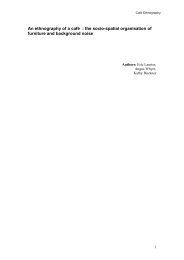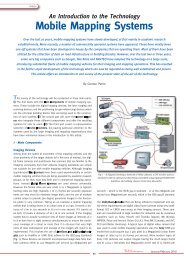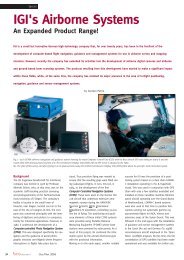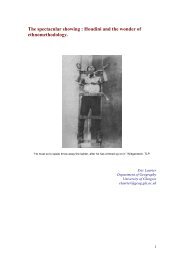MERIS atmospheric water vapor correction model for Wide Swath ...
MERIS atmospheric water vapor correction model for Wide Swath ...
MERIS atmospheric water vapor correction model for Wide Swath ...
Create successful ePaper yourself
Turn your PDF publications into a flip-book with our unique Google optimized e-Paper software.
GRSL-00404-2011 <<br />
Abstract—A major source of error <strong>for</strong> repeat-pass<br />
Interferometric Synthetic Aperture Radar (InSAR) is the phase<br />
delay in radio signal propagation through the atmosphere,<br />
especially the part due to tropospheric <strong>water</strong> <strong>vapor</strong>. These effects<br />
become more significant <strong>for</strong> ScanSAR observations due to their<br />
wider coverage (e.g. 400 km × 400 km <strong>for</strong> Envisat ASAR <strong>Wide</strong><br />
<strong>Swath</strong> Mode vs 100 km × 100 km <strong>for</strong> ASAR Image Mode). In this<br />
paper, we demonstrate <strong>for</strong> the first time that a <strong>MERIS</strong> <strong>water</strong><br />
<strong>vapor</strong> <strong>correction</strong> <strong>model</strong> can significantly reduce <strong>atmospheric</strong><br />
<strong>water</strong> <strong>vapor</strong> effects on ASAR WS interferograms, with the phase<br />
variation in non-de<strong>for</strong>ming areas decreasing from 3.8 cm be<strong>for</strong>e<br />
<strong>correction</strong> to 0.4 cm after <strong>correction</strong>.<br />
Index Terms—<strong>MERIS</strong>, Radar interferometry, ScanSAR,<br />
Water <strong>vapor</strong> <strong>correction</strong>, <strong>Wide</strong> <strong>Swath</strong> InSAR<br />
M<br />
<strong>MERIS</strong> <strong>atmospheric</strong> <strong>water</strong> <strong>vapor</strong> <strong>correction</strong><br />
<strong>model</strong> <strong>for</strong> <strong>Wide</strong> <strong>Swath</strong> Interferometric Synthetic<br />
Aperture Radar<br />
Zhenhong Li, Member, IEEE, Paolo Pasquali, Alessio Cantone, Andrew Singleton, Gareth Funning,<br />
David Forrest<br />
I. INTRODUCTION<br />
ost synthetic aperture radar (SAR) satellites operate in<br />
Stripmap (Image) Mode, whereby a single fixed antenna<br />
illuminates a fixed-width area, or ‘swath’, on the ground.<br />
Since imaging resolution in the radar azimuth (along-track)<br />
direction is related to the interval between radar pulses at the<br />
same radar incidence angle, fixing the antenna allows short<br />
repeat times such that typical azimuth resolutions are meters to<br />
tens of meters (e.g. about 4 m <strong>for</strong> Envisat Advanced Synthetic<br />
Aperture Radar (ASAR)). The ASAR instrument is able to<br />
switch its radar beam between seven different incidence<br />
angles in Image Mode, its swath width varying from 56 km<br />
(swath 7, average incidence angle 44º from the vertical) to 100<br />
Manuscript received July 12, 2011; revised August 11, 2011; accepted<br />
August 17, 2011. This work was supported by the Natural Environmental<br />
Research Council (NERC) through the GAS project (Ref: NE/H001085/1) and<br />
the National Centre of Earth Observation (NCEO) of which the Centre <strong>for</strong> the<br />
Observation and Modelling of Earthquakes, Volcanoes and Tectonics<br />
(COMET+, http://comet.nerc.ac.uk) is a part. Part of this work was supported<br />
by a China NSFC project (No. 41074005) and a China 863<br />
(No.2009AA12Z317) project.<br />
Zhenhong Li, Andrew Singleton and David Forrest are with School of<br />
Geographical and Earth Sciences, University of Glasgow, Glasgow G12 8QQ,<br />
UK (phone: +44-141-330-2289; fax: +44-141-330-4894; e-mail:<br />
Zhenhong.Li@glasgow.ac.uk).<br />
Paolo Pasquali and Alessio Cantone are with sarmap s.a., Cascine di<br />
Barico, 6989 Purasca, Switzerland.<br />
Gareth Funning is with Department of Earth Sciences, University of<br />
Cali<strong>for</strong>nia, Riverside, CA 92521, USA.<br />
km (swath 1, average incidence 19º from the vertical). Thus,<br />
although conventional Image Mode data can image the ground<br />
at high resolution, the swath width is typically narrow.<br />
This constraint can be overcome by utilizing the ScanSAR<br />
principle, whereby short bursts of data are acquired at<br />
different radar incidence angles. By changing the incidence<br />
angle at regular short intervals, multiple swath images (5 subswaths<br />
in total <strong>for</strong> ASAR) can be obtained in a single satellite<br />
pass. These can then be combined into a single large swath,<br />
greatly increasing the areal coverage, albeit at the expense of<br />
azimuth resolution. The <strong>Wide</strong> <strong>Swath</strong> (WS) ASAR image<br />
generated in this way covers a region of 400 km × 400km with<br />
a spatial resolution of c. 150 m × 150 m. The wide coverage of<br />
ScanSAR products reduces the need <strong>for</strong> postprocessing to<br />
mosaic large de<strong>for</strong>mation maps and digital elevation <strong>model</strong>s<br />
(DEMs) [1].<br />
Atmospheric <strong>water</strong> <strong>vapor</strong> effects represent one of the major<br />
limitations of repeat-pass interferometric SAR (InSAR),<br />
especially <strong>for</strong> small amplitude geophysical signals with long<br />
wavelengths, such as interseismic de<strong>for</strong>mation and some<br />
anthropogenic processes. Zebker et al. [2] suggested that a<br />
20% spatial or temporal change in relative humidity could<br />
result in a 10-14 cm error in two-pass InSAR de<strong>for</strong>mation<br />
retrievals, independent of baseline parameters. The wider<br />
coverage of the WS product makes it more vulnerable to<br />
tropospheric <strong>water</strong> <strong>vapor</strong> variations than the Image Mode<br />
product, since the decorrelation distance of <strong>water</strong> <strong>vapor</strong> can be<br />
between 500 and 1000 km [3].<br />
Space-based monitoring is an effective way to obtain global<br />
measurements of <strong>water</strong> <strong>vapor</strong> distributions with a high spatial<br />
resolution (e.g. 0.3 km × 0.3 km), and calibration techniques<br />
to spatially reduce path delays using the ESA MEdium<br />
Resolution Imaging Spectrometer (<strong>MERIS</strong>) data have been<br />
successfully demonstrated [4-8]. Launched together with<br />
ASAR on the ESA ENVISAT spacecraft on 1 March 2002,<br />
<strong>MERIS</strong> is a passive push-broom imaging instrument and<br />
measures the solar radiation reflected from the Earth’s surface<br />
and clouds in the visible and near IR spectral range during the<br />
daytime [9]. <strong>MERIS</strong> has two out of fifteen narrow spectral<br />
channels in the near IR <strong>for</strong> the remote sensing of <strong>water</strong> <strong>vapor</strong><br />
either above land or ocean surfaces under cloud free<br />
conditions [10], or above the highest cloud level under cloudy<br />
conditions [11]. Spatio-temporal comparisons show c. 1.1 mm<br />
1
GRSL-00404-2011 <<br />
agreement between <strong>MERIS</strong> and GPS/radiosonde <strong>water</strong> <strong>vapor</strong><br />
products in terms of standard deviations [5]. <strong>MERIS</strong> near IR<br />
data have been used to reduce <strong>water</strong> <strong>vapor</strong> effects on ASAR<br />
IM interferograms, and application of the <strong>MERIS</strong> <strong>correction</strong><br />
<strong>model</strong>s to ASAR data over the Los Angeles region showed the<br />
order of <strong>water</strong> <strong>vapor</strong> effects on interferograms can be reduced<br />
Fig. 1. Coverage of ASAR Image Mode (small, black dashed rectangle),<br />
ASAR <strong>Wide</strong> <strong>Swath</strong> (black gradational rectangle) and full resolution <strong>MERIS</strong><br />
(large, white dashed rectangle) over the Bam (Iran) region. (a) Black star<br />
indicates the epicenter of the 2003 Bam (Iran) earthquake [13]; (b) Black<br />
dashed rectangle denotes the coverage of ASAR Image <strong>Swath</strong> 2 (IS2); (c)<br />
The five stripes with different colors (from dark grey to light grey to white)<br />
in the WS track imply 5 sub swaths.<br />
from ~10 mm to ~5 mm after <strong>correction</strong> [6].<br />
In this paper, we evaluate a <strong>MERIS</strong> <strong>water</strong> <strong>vapor</strong> <strong>correction</strong><br />
<strong>model</strong> <strong>for</strong> WS InSAR. It is clear that the <strong>MERIS</strong> <strong>correction</strong><br />
<strong>model</strong> <strong>for</strong> WS InSAR has several advantages over that <strong>for</strong> IM<br />
InSAR: (i) <strong>MERIS</strong> near IR <strong>water</strong> <strong>vapor</strong> products are available<br />
at two nominal spatial resolutions: 0.3 km <strong>for</strong> full resolution<br />
(FR) mode, and 1.2 km <strong>for</strong> reduced resolution (RR) mode. WS<br />
images have a more comparable spatial resolution to <strong>MERIS</strong><br />
data than IM images (150 m <strong>for</strong> WS vs. 30 m <strong>for</strong> IM); (ii) the<br />
spatial coverage of WS images is also more comparable to<br />
<strong>MERIS</strong> images than that of IM images. It should be noted that<br />
WS ASAR sub-swath 5 does not fall within the <strong>MERIS</strong><br />
coverage as shown in Fig. 1.<br />
II. <strong>MERIS</strong> WATER VAPOR CORRECTION MODEL FOR WS<br />
INSAR<br />
A <strong>MERIS</strong> <strong>water</strong> <strong>vapor</strong> <strong>correction</strong> <strong>model</strong> has been<br />
successfully incorporated into the sarmap SARscape package<br />
[12]. As shown in Fig. 2, this <strong>model</strong> involves the usual steps<br />
of image co-registration, interferogram <strong>for</strong>mation, and<br />
interferogram flattening and removal of the topographic signal<br />
by use of a DEM. At this point, the integration approach<br />
diverges from the usual interferometric processing sequence<br />
with the insertion of a zenith-path-delay difference map<br />
(ZPDDM) [6], which aims to reduce <strong>water</strong> <strong>vapor</strong> variations in<br />
interferograms be<strong>for</strong>e phase unwrapping. The ZPDDM is<br />
derived from cloud-free <strong>MERIS</strong> near IR <strong>water</strong> <strong>vapor</strong><br />
observations [4, 6], mapped from the geographic coordinate<br />
system to the radar coordinate system (range and azimuth) and<br />
subtracted from the interferogram. This corrected<br />
interferogram can be unwrapped and an adjusted baseline can<br />
be estimated by minimizing the difference between the Slant-<br />
Range-projected reference DEM and a simulated height map<br />
converted from the unwrapped phase over ground control<br />
points (GCPs). Note that the baseline refinement step is<br />
optional and only desirable if there is an overall tilt in the<br />
unwrapped phase across the interferogram. The geocoding<br />
procedure maps the corrected unwrapped phase values from<br />
the radar coordinate system into the DEM-based coordinate<br />
system, and converts the unwrapped phase values to range<br />
Fig. 2. Flowchart of <strong>Wide</strong> <strong>Swath</strong> InSAR processing with <strong>MERIS</strong> <strong>water</strong> <strong>vapor</strong><br />
<strong>correction</strong>.<br />
changes in the radar line of sight.<br />
III. APPLICATION OF THE <strong>MERIS</strong> MODEL TO THE BAM EARTHQUAKE<br />
A pair of ENVISAT ASAR WS images over the Bam (Iran)<br />
region on the descending (satellite moving south) track 306<br />
(indicated as a black rectangle in Fig. 1) was processed from<br />
the ASAR level 0 (raw data) products using the SARscape<br />
software [12]. Effects of topography were removed from the<br />
interferograms using a 3-arc-second (~90 m) posting digital<br />
elevation <strong>model</strong> (DEM) produced by the Space Shuttle Radar<br />
Topography Mission (SRTM) [13]. The WS interferogram has<br />
a perpendicular baseline of 110m, and the error in the SRTM<br />
DEM (i.e. nominally 8 m in Eurasia, [13]) might lead to a<br />
phase error of up to 0.67 radians (equivalent to a range change<br />
of 0.3 cm in the radar line of sight). There<strong>for</strong>e the topographic<br />
phase contribution can be considered negligible.<br />
Fig. 3(a) shows the original wrapped interferogram in the<br />
radar coordinate system. Asymmetric de<strong>for</strong>mation signals can<br />
be observed in the epicentre region (indicated by a black<br />
rectangle), the pattern of which is similar to the descending IM<br />
interferogram (track 120) as shown in Fig. 4(b) in Funning et<br />
al. (2005). It is also clear in Fig. 3(a) that there are five<br />
irregular fringes in the far field across the 400 km × 400 km<br />
region. After refining the baseline using 44 GCPs (indicated as<br />
2
GRSL-00404-2011 <<br />
white crosses in Fig. 3(a)), 3-4 irregular fringes remain in the<br />
far field (mainly in the north part of the interferogram; Fig.<br />
3(b)). These residual phases are caused by the spatiotemporal<br />
variations of tropospheric <strong>water</strong> <strong>vapor</strong> distribution between the<br />
acquisitions, which are evident in the zenith path delay<br />
difference map (ZPDDM) derived from <strong>MERIS</strong> near IR <strong>water</strong><br />
<strong>vapor</strong> products (Fig. 4). After applying <strong>MERIS</strong> <strong>water</strong> <strong>vapor</strong><br />
<strong>correction</strong>, five parallel fringes (oriented approximately<br />
parallel to the track direction) can be observed in the far field<br />
(Fig. 3(c)). Note the grey strip in the right of the corrected<br />
interferogram is due to sub-swath 5 being outside the <strong>MERIS</strong><br />
coverage as previously mentioned. As shown in Fig. 3(d), the<br />
five parallel fringes disappeared after applying baseline<br />
refinement with 33 GCPs (indicated as white crosses in Fig.<br />
3(c)). Phase variation of the unwrapped WS interferogram in<br />
the far field (i.e. the area that did not undergo de<strong>for</strong>mation in<br />
the earthquake) decreased from 8.4 rad (equivalent to a LOS<br />
range change of 3.8 cm) without <strong>correction</strong> to 0.9 rad<br />
(equivalent to a LOS range change of 0.4 cm) after applying<br />
the <strong>MERIS</strong> <strong>water</strong> <strong>vapor</strong> <strong>correction</strong> <strong>model</strong>, implying that the<br />
unwrapped phase was much flatter after <strong>correction</strong>. Note that<br />
the reduction of the phase variation in the non-de<strong>for</strong>ming area<br />
can be representative of the per<strong>for</strong>mance of the <strong>MERIS</strong> <strong>water</strong><br />
Fig. 3. <strong>Wide</strong> swath Interferogram 030902-040608 in the radar coordinate<br />
system: (a) Original interferogram be<strong>for</strong>e baseline refinement; (b) Original<br />
interferogram after baseline refinement; (c) Interferogram with <strong>water</strong> <strong>vapor</strong><br />
<strong>correction</strong>; (d) <strong>water</strong> <strong>vapor</strong> corrected interferogram after baseline refinement.<br />
Note: (1) black crosses in (a) and (c) represent ground control points used in<br />
baseline refinement; (2) white rectangles in (a) and (c) denote the de<strong>for</strong>ming<br />
area due to the 2003 Bam earthquake.<br />
<strong>vapor</strong> <strong>correction</strong> <strong>model</strong> to the WS interferogram.<br />
In order to further validate the per<strong>for</strong>mance of our <strong>MERIS</strong><br />
<strong>correction</strong> <strong>model</strong>, a comparison was per<strong>for</strong>med between the<br />
corrected WS interferogram and the two-fault, variable-slip<br />
dislocation <strong>model</strong> of the 2003 Bam earthquake by Funning et<br />
al. [14]. Using IM interferograms from both ascending and<br />
descending tracks, Funning et al. [14] claimed that the<br />
de<strong>for</strong>mation pattern observed by InSAR can be best explained<br />
Fig. 4. (a) Zenith Wet Delays (ZWD) derived from <strong>MERIS</strong> near IR <strong>water</strong><br />
<strong>vapor</strong> products on 02 September 2003; (b) ZWD derived from <strong>MERIS</strong> near IR<br />
<strong>water</strong> <strong>vapor</strong> products on 08 June 2004; (c) ZPDDM = ZWD b - ZWD a . Note:<br />
(1) A conversion factor of 6.2 was employed to convert <strong>water</strong> <strong>vapor</strong> to ZWD,<br />
which can be calculated using surface temperature measurements obtained<br />
from radiosondes [3]; (2) Black rectangles denote the coverage of Fig. 3(c)<br />
and 3(d) and are identical to the coverage of the geocoded WS interferogram<br />
after <strong>water</strong> <strong>vapor</strong> <strong>correction</strong> as shown in Fig. 5(a).<br />
by slip on two subparallel faults: one blind strike-slip fault<br />
extending under the center of Bam and a second dipping<br />
64°W, striking parallel to, and east of, the main strike-slip<br />
fault. They showed the root mean squared (RMS) misfit of<br />
observed-to-<strong>model</strong>ed ground displacements was 1.3 cm in the<br />
near field with some residual fringes remaining due to<br />
Fig. 5. <strong>Wide</strong> <strong>Swath</strong> (WS) Interferograms superimposed on a SRTM DEM. (a)<br />
Corrected WS interferogram using <strong>MERIS</strong> <strong>correction</strong> <strong>model</strong>; (b) Modeled WS<br />
interferogram from the two fault variable slip <strong>model</strong> of the Bam earthquake by<br />
Funning et al. [13]; (c) residual interferogram. Note: Black rectangles denote<br />
the de<strong>for</strong>ming area due to the 2003 Bam earthquake.<br />
un<strong>model</strong>ed fault complexity.<br />
The <strong>water</strong> <strong>vapor</strong> corrected WS interferogram is shown in<br />
Fig. 5(a), the <strong>model</strong> WS interferogram in Fig. 5(b), and their<br />
residuals in Fig. 5(c). It is clear that the two-fault variable slip<br />
<strong>model</strong> by Funning et al. [14] can reproduce the main features<br />
of the WS interferogram. The misfit to the WS data in the near<br />
field is 1.1 cm, which is on the same order of that to the IM<br />
data (i.e. 1.3 cm) [14]. Note that the difference in the RMS<br />
misfit values obtained can be attributed to the different source<br />
of interferograms, and the sampling of the interferograms. On<br />
close inspection of the residual WS interferogram, it is found<br />
that the pattern of the remaining residual fringes is similar to<br />
that of the descending IM interferogram shown in [14, Fig.<br />
12(b)]. The RMS misfit of observed-to-<strong>model</strong>ed ground<br />
displacements to the whole corrected WS interferogram is 0.6<br />
cm. It is worth pointing out that the RMS misfit to the original<br />
WS interferogram (without <strong>water</strong> <strong>vapor</strong> <strong>correction</strong>) is 3.1 cm,<br />
suggesting a reduction of 2.5 cm due to tropospheric <strong>water</strong><br />
<strong>vapor</strong> effects in the WS interferogram in reference to the<br />
Funning’s variable-slip dislocation <strong>model</strong>.<br />
3
GRSL-00404-2011 <<br />
IV. DISCUSSION AND CONCLUSIONS<br />
This paper has demonstrated a <strong>MERIS</strong> <strong>water</strong> <strong>vapor</strong><br />
<strong>correction</strong> <strong>model</strong> <strong>for</strong> WS InSAR <strong>for</strong> the first time. This<br />
<strong>correction</strong> <strong>model</strong> has been successfully incorporated into the<br />
commercial SARscape package, and its application to ASAR<br />
WS data suggests that the uncertainty in WS interferograms<br />
can be decreased from 3.8 cm be<strong>for</strong>e <strong>correction</strong> to 0.4 cm after<br />
<strong>correction</strong>.<br />
There are two limitations of the <strong>MERIS</strong> <strong>water</strong> <strong>vapor</strong><br />
<strong>correction</strong> <strong>model</strong>: (i) The <strong>MERIS</strong> <strong>correction</strong> <strong>model</strong> is only<br />
applicable under cloud-free conditions, since <strong>MERIS</strong> near-IR<br />
<strong>water</strong> <strong>vapor</strong> products are sensitive to the presence of clouds. It<br />
should be noted that the Middle-East, North Africa, South<br />
Africa, Australia, Chile, Antarctica, Southern Cali<strong>for</strong>nia and<br />
North Mexico still show cloud-free frequencies as high as<br />
60% or even more [4]. (ii) The <strong>MERIS</strong> <strong>correction</strong> <strong>model</strong> only<br />
works <strong>for</strong> ASAR sub-swaths 1, 2, 3 and 4, as sub-swath 5 does<br />
not fall within the <strong>MERIS</strong> coverage (Fig. 1).<br />
An online system called OSCAR (Online Services <strong>for</strong><br />
Correcting Atmosphere in Radar) is being developed at the Jet<br />
Propulsion Laboratory to provide estimates of the <strong>atmospheric</strong><br />
path delays <strong>for</strong> SAR images and InSAR pairs. OSCAR uses a<br />
variety of different data sources to estimate tropospheric <strong>water</strong><br />
<strong>vapor</strong> at high spatial resolutions <strong>for</strong> any chosen SAR image<br />
date and time. Current data sources include <strong>water</strong> <strong>vapor</strong><br />
measurements from the NASA MODerate-resolution Imaging<br />
Spectrometer (MODIS) and the European Centre <strong>for</strong> Mediumrange<br />
Weather Forecasting (ECMWF), and advanced<br />
interpolation techniques have been developed to make<br />
estimates where MODIS observations are not available [15].<br />
Water <strong>vapor</strong> measurements from <strong>MERIS</strong>, AIRS (the NASA<br />
Atmospheric InfraRed Sounder) and GPS in certain areas with<br />
high-density networks will be employed to correct <strong>for</strong> the<br />
<strong>atmospheric</strong> effects of InSAR observations in the OSCAR<br />
system in the near future. Our recent validation study showed<br />
that the OSCAR-derived <strong>water</strong> <strong>vapor</strong> estimates agreed well<br />
with GPS <strong>water</strong> <strong>vapor</strong> products, with a correlation coefficient<br />
of 0.96 and a standard deviation of 2 mm [16], suggesting that<br />
OSCAR-based <strong>water</strong> <strong>vapor</strong> <strong>correction</strong>s show promise <strong>for</strong><br />
improving WS InSAR measurements.<br />
ACKNOWLEDGMENT<br />
All ENVISAT SAR and <strong>MERIS</strong> data are copyrighted by the<br />
European Space Agency and were provided under project AO-<br />
6440. We are grateful to Juan M. Lopez-Sanchez and an<br />
anonymous reviewer <strong>for</strong> constructive reviews.<br />
REFERENCES<br />
[1] J. Holzner and R. Bamler, "Burst-mode and ScanSAR Interferometry,"<br />
IEEE Trans. Geosci. Remote Sens., vol. 40, pp. 1917-1934, Sept. 2002.<br />
[2] H. A. Zebker, P. A. Rosen, and S. Hensley, “Atmospheric effects in<br />
interferometric synthetic aperture radar surface de<strong>for</strong>mation and<br />
topographic maps”, J. Geophys. Res., vol. 102, pp. 7547-7563, 1997.<br />
[3] T. R. Emardson, F. H. Webb, and P. O. J. Jarlemark, "Analysis of <strong>water</strong><br />
<strong>vapor</strong> spatial variability using GPS, InSAR, microwave radiometer, and<br />
radiosonde data," Jet Propulsion Laboratory, Pasadena, Cali<strong>for</strong>nia 2002.<br />
[4] Z. Li, E. J. Fielding, P. Cross, and R. Preusker, "Advanced InSAR<br />
<strong>atmospheric</strong> <strong>correction</strong>: <strong>MERIS</strong>/MODIS combination and stacked <strong>water</strong><br />
vapour <strong>model</strong>s," Int. J. Remote Sens., vol. 30, pp. 3343-3363, July 2009.<br />
[5] Z. Li, J.-P. Muller, P. Cross, P. Albert, J. Fischer, and R. Bennartz,<br />
"Assessment of the potential of <strong>MERIS</strong> near-infrared <strong>water</strong> vapour<br />
products to correct ASAR interferometric measurements," Int. J. Remote<br />
Sens., vol. 27, pp. 349-365, Jan. 2006.<br />
[6] Z. Li, E. J. Fielding, P. Cross, and J.-P. Muller, "Interferometric<br />
synthetic aperture radar <strong>atmospheric</strong> <strong>correction</strong>: MEdium Resolution<br />
Imaging Spectrometer and Advanced Synthetic Aperture Radar<br />
integration," Geophys. Res. Lett., vol. 33, pp. L06816, Mar. 2006.<br />
[7] B. Puysségur, R. Michel, and J. Avouac, "Tropospheric phase delay in<br />
interferometric synthetic aperture radar estimated from meteorological<br />
<strong>model</strong> and multispectral imagery," J. Geophys. Res., vol. 112, pp.<br />
B05419, May 2007.<br />
[8] W. Xu, Z. Li, X. Ding, G. Feng, J. Hu, J. Long, H. Yin, and Y. Yang,<br />
"Correcting <strong>atmospheric</strong> effects in ASAR interferogram with <strong>MERIS</strong><br />
integrated <strong>water</strong> <strong>vapor</strong> data," Chin. J. Geophys. (in Chinese), vol. 53, pp.<br />
1073-1084, May 2010.<br />
[9] <strong>MERIS</strong> Product Handbook. Issue 2.1, ESA. Available from:<br />
http://envisat.esa.int/pub/ESA_DOC/ENVISAT/<strong>MERIS</strong>/meris.ProductH<br />
andbook.2_1.pdf<br />
[10] R. Bennartz and J. Fischer, "Retrieval of columnar <strong>water</strong> vapour over<br />
land from back-scattered solar radiation using the Medium Resolution<br />
Imaging Spectrometer (<strong>MERIS</strong>)," Remote Sens.Environ., vol. 78, pp.<br />
271-280, Dec. 2001.<br />
[11] P. Albert, R. Bennartz, and J. Fischer, "Remote Sensing of Atmospheric<br />
Water Vapor from Backscattered Sunlight in Cloudy Atmospheres," J<br />
Atmos.Oceanic Technol., vol. 18, pp. 865-874, June 2001.<br />
[12] SARscape. Sarmap. Available from<br />
http://www.sarmap.ch/pdf/SARscapeTechnical.pdf.<br />
[13] T. G. Farr, P. A. Rosen, E. Caro, R. Crippen, R. Duren, S. Hensley, M.<br />
Kobrick, M. Paller, E. Rodriguez, L. Roth, D. Seal, S. Shaffer, J.<br />
Shimada, J. Umland, M. Werner, M. Oskin, D. Burbank and D. Alsdorf,<br />
"The Shuttle Radar Topography Mission," Rev. Geophys, vol. 45, pp.<br />
RG2004, May 2007.<br />
[14] G. J. Funning, B. Parsons, T. J. Wright, J. A. Jackson, and E. J. Fielding,<br />
"Surface displacements and source parameters of the 2003 Bam (Iran)<br />
earthquake from Envisat advanced synthetic aperture radar imagery," J.<br />
Geophys. Res., vol. 110, pp. B09406, Sept. 2005.<br />
[15] P. von Allmen, E. Fielding, E. Fishbein, Z. Xing, L. Pan, M. Lo, and Z.<br />
Li, “OSCAR: Online Services <strong>for</strong> Correction of Atmosphere in Radar”<br />
in 2011 Earth Science Technology Gorum (ESTF2011), Pasadena, CA,<br />
2011, pp 1-5.<br />
[16] P. von Allmen, Z. Xing, E. Fielding, E. Fishbein, L. Pan, and Z. Li,<br />
"OSCAR: Online Service <strong>for</strong> Correcting Atmosphere in Radar," in AGU<br />
Fall Meeting, San Francisco, CA, 2010.<br />
4
















